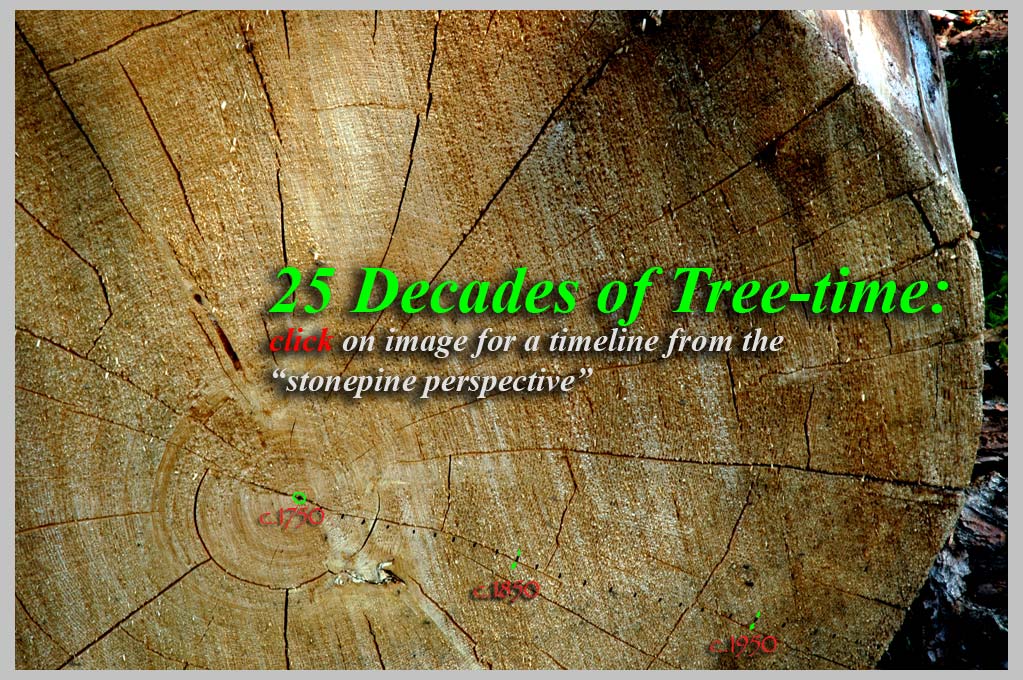
Stonepine Timeline (Whitebark Pine, Pinus albicaulus), Eagle Cap Wilderness | click here or on photo |
On the road in the American Northwest.

Stonepine Timeline (Whitebark Pine, Pinus albicaulus), Eagle Cap Wilderness | click here or on photo |
On the road in the American Northwest.
WHEN GROWTH IS 'FALSE COMPARE'
We shape the world and the world shapes us.
"What grows is good.
And if something is good,
it is good to want more of it..."
O Irony of ironies! Behind the intellectual facade of economic
growth lies the harsh, hidden reality of a very real natural
anti-growth. Anti-growth is the wholesale destruction, either
by means of over-use or contamination or both, of the shared
vital resources of the world community such as air, water,
forests and soil. Anti-growth is not just an unfortunate
side-effect; it is an absolute necessity needed to fire the
engines—and that is the ironic twist here—that sustain
the illusion projected by what in essence is a false analogy.
Let me start over again:
As every poet knows, there's nothing worse than, to use
Shakespeare's phrase, 'false compare.'
Language shapes perception. And perception shapes
action. Analogy, or the this-is-like-that of thought, is finding
similarity in difference, a common feature in seemingly
different patterns of movement.
For example, we say: "Forests grow." And by analogy, we
say: "Economies grow." We all know that forests actually
grow, whereas the transference of growth as a property to
describe patterns of change in economies is an entirely
different matter. This may be more or less true, or it may
be false.
My contention is that it is false.
But let's consider natural growth for a moment.
As we all know, from the human perspective, growth is
more often than not a slow, steady process. So slow in
fact that we normally can't see it. That is why time-lapse
photography of a flower bud unfolding, or a glacier retreating,
is so revealing. Natural growth is frequently measured in
areas of space so small, and spans of time so long, that it
lies beyond the grasp of both our normal sense of proportion
and perception. For example, lichen grow about 1 centimeter
a century; Or the humus layer of soil around treeline increases
its depth 10 times slower yet: about a centimeter every
thousand years. That's about 30 human generations for
every finger-width of soil stable enough to support the
alpine grasses under your boots!
A second key point is that natural growth is normally cyclical.
And it is cyclical in a highly rhythmic way. As everywhere in
Nature, there are limits. And because there are limits, there
is balance. In other words: without limits, there can be no
balance; as well as the inverse: if there is imbalance, limits
have somehow broken down. So natural growth is not
normally simply a matter of endless linear expansion, and
especially not the species of expansion known as exponential
increase, as I've argued elsewhere. Increase or expansion in
Nature is always balanced by a complementary and equally
essential movement of contraction, decline and, ultimately,
death. Nowhere do we see this from the human perspective
more clearly than the life of the soil, to which we all know that
we too shall return some day, and which depends on this
continuous composting and transformation of dead and
dying organisms for its sustained vitality.
Now let's return briefly to the false analogy.
When politicians or theorists speak of economic growth,
they do not have in mind anything remotely similar to the
.01 mill growth rate of the mountain soils mentioned above.
They are really thinking of largely unnatural systems of
linear expansion—a kind of always 'gitting bigger' stretching
onto without limit to infinity—as well as the notorious
expansion-of-expansion of compound interest. Who would
not, after all. If you are focused on dollars or euro amounts,
a change or expansion rate of just 5% compound interest
will more than double your money in just 16 years! But how
long can this unlimited interest-on-top-of-interest continue
before it collapses, as it must? In contrast, natural growth
is by definition always limited and self-sustaining. And, as
suggested above, in a vicious inversion of meaning, that
the real growth of the natural world, like that of the stonepine
pictured above or the forest in which it grew, will be razed
to the ground in order to sustain the illusion. In my opinon,
this is actually the case.
And so we come full circle to the dead-end of the speculative
mind, so at odds with the forester's, or farmer's, or rancher's
point of view. It is a confused and confusing notion of growth
which rests on the hope and downfall of every gambler:—
that each toss of the dice will result in the impossibility of
a straight series of wins going on without end.
A shaky notion of growth and 'false compare,' indeed!
Broken Bridge Camp,
Eagle Cap Wilderness,
Oregon, X.29.2008
Please visit my picture-poems.com print gallery.
Above is a set of 45 recent images.(Mouseover controls.)
I might just mention here, following the ethical principle,
First, do no harm, I never use cars or snowmachine. I
do everything on foot, bike or ski. I think this in a
deep and direct way affects my work, and how I see
the world. So all the photos above were approached
on foot, including all the in between spaces, sometimes
involving journeys of weeks or months.
I would not want to work any other way.
